On this Page
Overview
You can use the Snowflake - Bulk Upsert Snap to bulk update the records if present or inserts records to the target Snowflake table.
Depending on the account that you configure with the Snap, you can use the Snowflake Bulk Upsert Snap to upsert data into AWS S3 buckets or Microsoft Azure Storage Blobs or Google Cloud Storage.
The Snap creates temporary files in the JCC when the staging location is internal and the data source is Input view. These temporary files are removed automatically after the pipeline completes execution.
Snap Type
The Snowflake - Bulk Upsert Snap is a Write-type Snap that performs a bulk upsert operation.
PrerequisitesYou must have minimum permissions on the database to execute Snowflake Snaps. To understand if you already have them, you must retrieve the current set of permissions. The following commands enable you to retrieve those permissions:
SHOW GRANTS ON DATABASE <database_name>
SHOW GRANTS ON SCHEMA <schema_name>
SHOW GRANTS TO USER <user_name>
SHOW GRANTS ON DATABASE <database_name> SHOW GRANTS ON SCHEMA <schema_name> SHOW GRANTS TO USER <user_name>
Security Prerequisites:
You should have the following permission in your Snowflake account to execute this Snap:
Usage (DB and Schema): Privilege to use the database, role, and schema.
The following commands enable minimum privileges in the Snowflake Console:
grant usage on database <database_name> to role <role_name>; grant usage on schema <database_name>.<schema_name>;
For more information on Snowflake privileges, refer to Access Control Privileges.
The below are mandatory when using an external staging location:
When using an Amazon S3 bucket for storage:
The Snowflake account should contain S3 Access-key ID, S3 Secret key, S3 Bucket and S3 Folder.
The Amazon S3 bucket where the Snowflake will write the output files must reside in the same region as your cluster.
When using a Microsoft Azure storage blob:
A working Snowflake Azure database account.
Internal SQL Commands
This Snap uses the following commands internally:
SELECT FROM TABLE: SELECT as a statement enables you to query the database and retrieve a set of rows. SELECT as a clause enables you to define the set of columns returned by a query.
COPY INTO <table>: Enables loading data from staged files to an existing table.
CREATE TEMPORARY TABLE: Enables creating temporary table in the database.
MERGE: Enables inserting, updating, and deleting values in a table based on values in a second table or a subquery.
Support for Ultra Pipelines
Works in Ultra Pipelines. However, we recommend that you not use this Snap in an Ultra Pipeline.
Limitations
The special character '~' is not supported if it is there in temp directory name for Windows. It is reserved for user's home directory.
Known Issues
Because of performance issues, all Snowflake Snaps now ignore the Cancel queued queries when pipeline is stopped or if it fails option for Manage Queued Queries, even when selected. Snaps behave as though the default Continue to execute queued queries when the Pipeline is stopped or if it fails option were selected.
Behavior Change
In the 4.31 main18944 release and later, the Snowflake - Bulk Upsert Snap no longer supports values from an upstream input document in the Key columns field when the expression button is enabled.
To avoid breaking your existing Pipelines that use a value from the input schema in the Key columns field, update the Snap settings to use an input value from Pipeline parameters instead.
Snap Views
Type | Format | Number of Views | Examples of Upstream and Downstream Snaps | Description |
|---|---|---|---|---|
Input | Document |
|
| Incoming documents are first written to a staging file on Snowflake's internal staging area. A temporary table is created on Snowflake with the contents of the staging file. An update operation is then run to update existing records in the target table and/or an insert operation is run to insert new records into the target table. |
Output | Document |
|
| If an output view is available, then the output document displays the number of input records and the status of the bulk upload as follows: |
Error | Error handling is a generic way to handle errors without losing data or failing the Snap execution. You can handle the errors that the Snap might encounter when running the Pipeline by choosing one of the following options from the When errors occur list under the Views tab:
Learn more about Error handling in Pipelines. | |||
Snap Settings
Asterisk (*): Indicates a mandatory field.
Suggestion icon (
 ): Indicates a list that is dynamically populated based on the configuration.
): Indicates a list that is dynamically populated based on the configuration.Expression icon (
 ): Indicates whether the value is an expression (if enabled) or a static value (if disabled). Learn more about Using Expressions in SnapLogic.
): Indicates whether the value is an expression (if enabled) or a static value (if disabled). Learn more about Using Expressions in SnapLogic.Add icon (
 ): Indicates that you can add fields in the field set.
): Indicates that you can add fields in the field set.Remove icon (
 ): Indicates that you can remove fields from the field set.
): Indicates that you can remove fields from the field set.
Field Name | Field Type | Field Dependency | Description |
|---|---|---|---|
Label* Default Value: Snowflake - Bulk Upsert | String | N/A | Specify the name for the instance. You can modify this to be more specific, especially if you have more than one of the same Snap in your Pipeline. |
Schema Name Default Value: N/A | String/Expression/Suggestion | N/A | Specify the database schema name. In case it is not defined, then the suggestion for the Table Name retrieves all tables names of all schemas. The property is suggestible and will retrieve available database schemas during suggest values. The values can be passed using the Pipeline parameters but not the upstream parameter. |
Table Name* Default Value: N/A | String/Expression/Suggestion | N/A | Specify the name of the table to execute bulk load operation on. The values can be passed using the Pipeline parameters but not the upstream parameter. |
Staging location Default Value: Internal | Dropdown list/Expression | N/A | Select the type of staging location that is to be used for data loading:
|
File format object Default Value: None Example: | String/Expression/Suggestion | N/A | Specify an existing file format object to use for loading data into the table. The specified file format object determines the format type such as CSV, JSON, XML, AVRO, or other format options for data files. |
File format type Default Value: None | Dropdown list | N/A | Specify a predefined file format object to use for loading data into the table. The available file formats include CSV, JSON, XML, and AVRO. |
File format option Default value: N/A | String/Expression | N/A | Specify the file format option. Separate multiple options by using blank spaces and commas. You can use various file format options including a binary format which passes through in the same way as other file formats. Learn more: File Format Type Options. Before loading binary data into Snowflake, you must specify the binary encoding format, so that Snap can decode the string type to binary types before loading it into Snowflake. This can be done by selecting the following binary file format:
However, the file you upload and download must be in similar formats. For instance, if you load a file in HEX binary format, you should specify the HEX format for download as well. |
Encryption type Default Value: None | Dropdown list | N/A | Specify the type of encryption to be used on the data. The available encryption options are:
The KMS Encryption option is available only for S3 Accounts (not for Azure Accounts) with Snowflake. If Staging Location is set to Internal, and when Data source is Input view, the Server Side Encryption and Server-Side KMS Encryption options are not supported for Snowflake snaps: This happens because Snowflake encrypts loading data in its internal staging area and does not allow the user to specify the type of encryption in the PUT API. Learn more: Snowflake PUT Command Documentation. |
KMS key Default Value: N/A | String/Expression | N/A | Specify the KMS key that you want to use for S3 encryption. Learn more about the KMS key: AWS KMS Overview and Using Server Side Encryption. This property applies only when you select Server-Side KMS Encryption in the Encryption Type field above. |
Buffer size (MB) Default Value: 10MB | String/Expression | N/A | Specify the data in MB to be loaded into the S3 bucket at a time. This property is required when bulk loading to Snowflake using AWS S3 as the external staging area. Minimum value: 6 MB Maximum value: 5000 MB S3 allows a maximum of 10000 parts to be uploaded so this property must be configured accordingly to optimize the bulk load. Refer to Upload Part for more information on uploading to S3. |
Key columns* Default Value: None | Specify the column to use for existing entries in the target table. The Key columns field does not support values from the upstream input document when the expression button is enabled. The value must be defined for all inputs and remain constant throughout the Snap execution. Therefore, the Snap supports expressions to include only constant pipeline parameters. If you are using a function to get or transform the value from a pipeline parameter, that value must evaluate to a value that is not null and is not empty at the time of pipeline execution. | ||
Delete Upsert Condition Default: N/A | String | N/A | Delete Upsert Condition when true, causes the case to be executed. |
Preserve case sensitivity Default Value: Deselected | Checkbox | N/A | Select this check box to preserve the case sensitivity of the column names.
|
Manage Queued Queries Default Value: Continue to execute queued queries when the Pipeline is stopped or if it fails | Dropdown list | N/A | Select this property to determine whether the Snap should continue or cancel the execution of the queued Snowflake Execute SQL queries when you stop the pipeline. If you select Cancel queued queries when the Pipeline is stopped or if it fails, then the read queries under execution are canceled, whereas the write type of queries under execution are not canceled. Snowflake internally determines which queries are safe to be canceled and cancels those queries. |
Load empty strings Default value: Selected | Checkbox | N/A | If selected, empty string values in the input documents are loaded as empty strings to the string-type fields. Otherwise, empty string values in the input documents are loaded as null. Null values are loaded as null regardless. |
Additional Options | |||
On Error Default Value: ABORT_STATEMENT | Dropdown list | N/A | Select an action to perform when errors are encountered in a file. The available actions are:
|
Error Limit Default Value: 0 | Integer | Appears when you select SKIP_FILE_*error_limit* for On Error. | Specify the error limit to skip file. When the number of errors in the file exceeds the specified error limit or when SKIP_FILE_number is selected for On Error. |
Error Percentage Limit Default Value: 0 | Integer | Appears when you select SKIP_FILE_*error_percent_limit*% | Specify the percentage of errors to skip file. If the file exceeds the specified percentage when SKIP_FILE_number% is selected for On Error. |
Snap Execution Default Value: Execute only | Dropdown list | N/A | Select one of the three modes in which the Snap executes. Available options are:
|
Troubleshooting
Error | Reason | Resolution |
|---|---|---|
Cannot lookup a property on a null value. | The value referenced in the Key Column field is null. This Snap does not support values from an upstream input document in the Key columns field when the expression button is enabled. | Update the Snap settings to use an input value from pipeline parameters and run the pipeline again. |
Data can only be read from Google Cloud Storage (GCS) with the supplied account credentials (not written to it). | Snowflake Google Storage Database accounts do not support external staging when the Data source is the Input view. Data can only be read from GCS with the supplied account credentials (not written to it). | Use internal staging if the data source is the input view or change the data source to staged files for Google Storage external staging. |
Example
Upserting Records
This example Pipeline demonstrates how you can efficiently update and delete data (rows) using the Key Column ID field and Upsert Delete condition. We use Snowflake - Bulk Upsert Snap to accomplish this task.
First, we configure the Mapper Snap with the required details to pass them as inputs to the downstream Snap.
After validation, the Mapper Snap prepares the output as shown below to pass to the Snowflake Bulk - Upsert Snap.
Next, we configure the Snowflake - Bulk Upsert Snap to:
Upsert the existing row for P_ID column, (so, we provide P_ID in the Key column field).
Delete the rows where the FIRSTNAME is snaplogic in the target table, (so, we specify FIRSTNAME = 'snaplogic' in the Delete Upsert Condition field).
After execution, this Snap inserts a new record into the existing row for the P_ID key column in Snowflake.
Inserted Records Output in JSON | Inserted Records in Snowflake |
|---|---|
Upon execution, if the Delete Upsert condition is true, the Snap deletes the records in the target table as shown below.
Output in JSON | Deleted Record in Snowflake |
|---|---|
Bulk Loading Records
In the following example, we update a record using the Snowflake Bulk Upsert Snap. The invalid records which cannot be inserted will be routed to an error view.
In the pipeline execution:
The Mapper (Data) Snap maps the record details to the input fields of Snowflake Upsert Snap:
Snowflake Upsert Snap updates the record using the "PRASANNA"."Persons" table object:
Successful execution of the pipeline displays the following data preview (Note that one input has been made and two records with the name P_ID have been updated within the Persons table.):
Downloads
Important steps to successfully reuse Pipelines
- Download and import the pipeline into the SnapLogic application.
- Configure Snap accounts as applicable.
- Provide pipeline parameters as applicable.
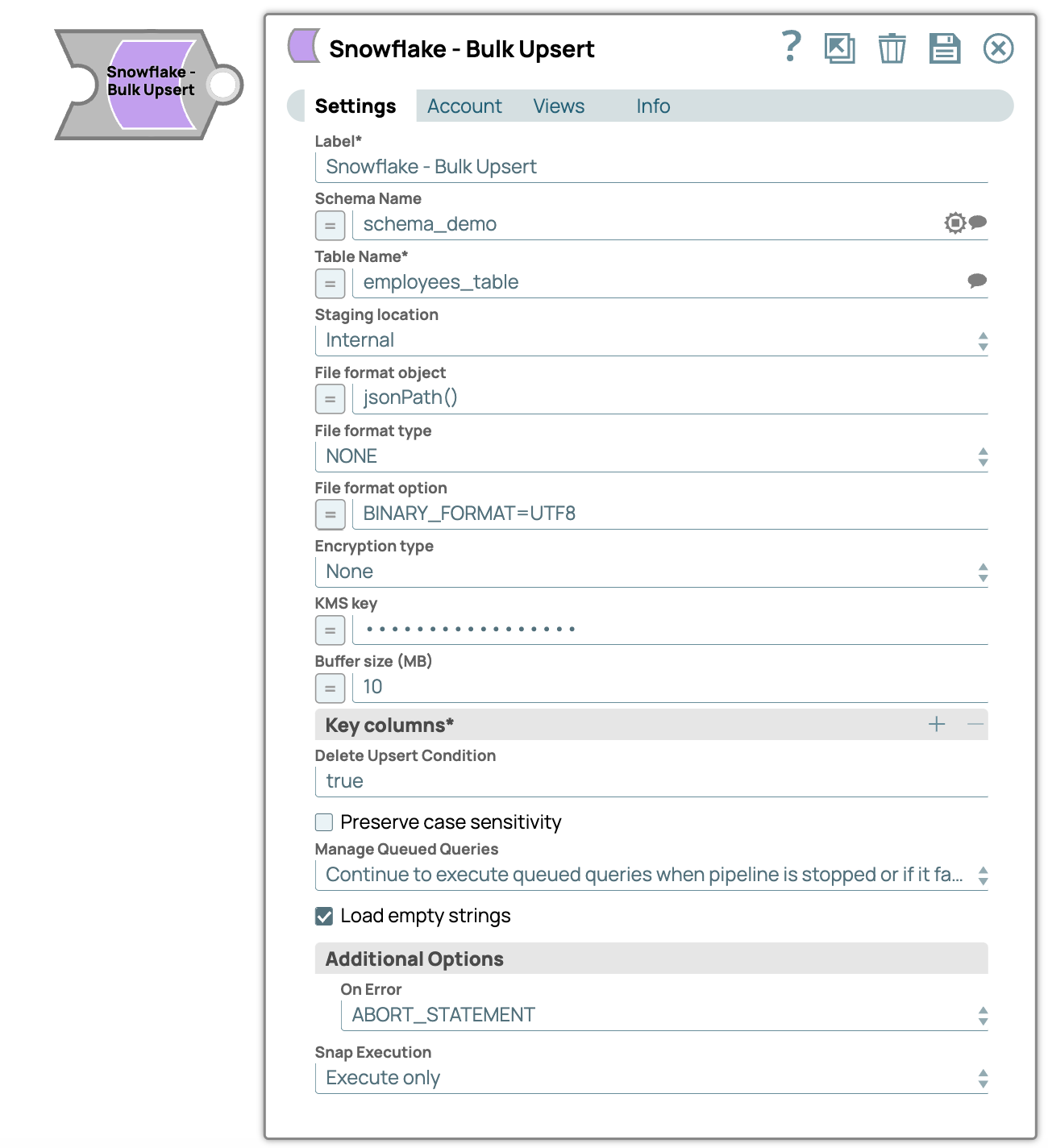

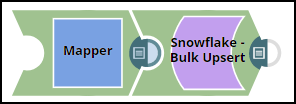

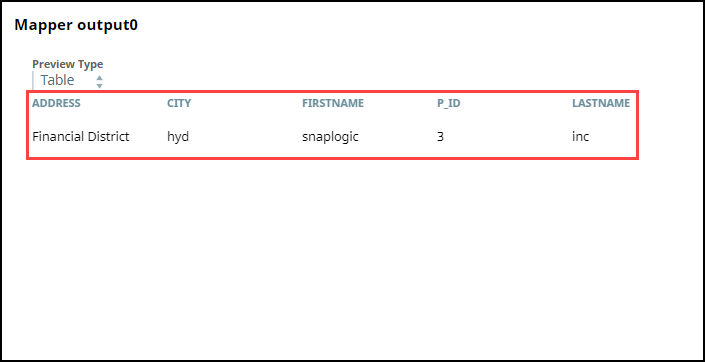
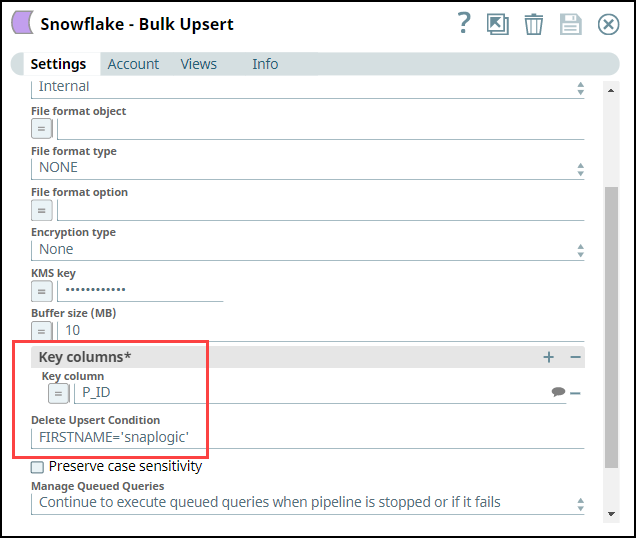




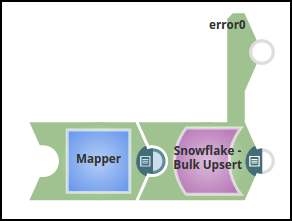
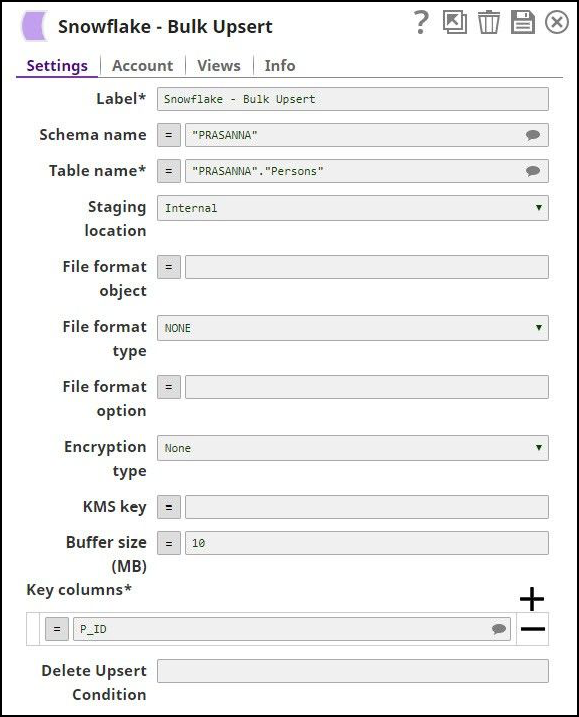
.png?version=1&modificationDate=1489733387721&cacheVersion=1&api=v2)